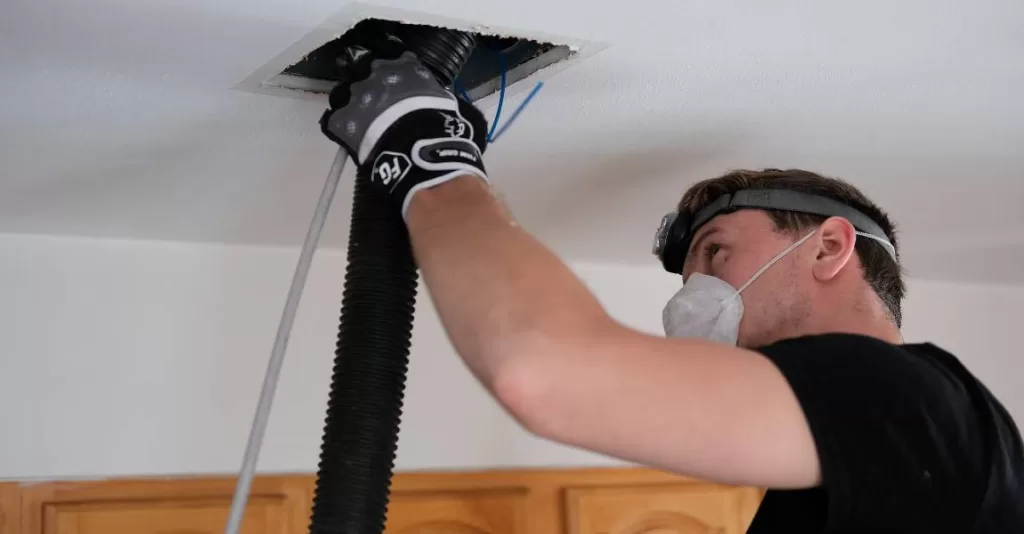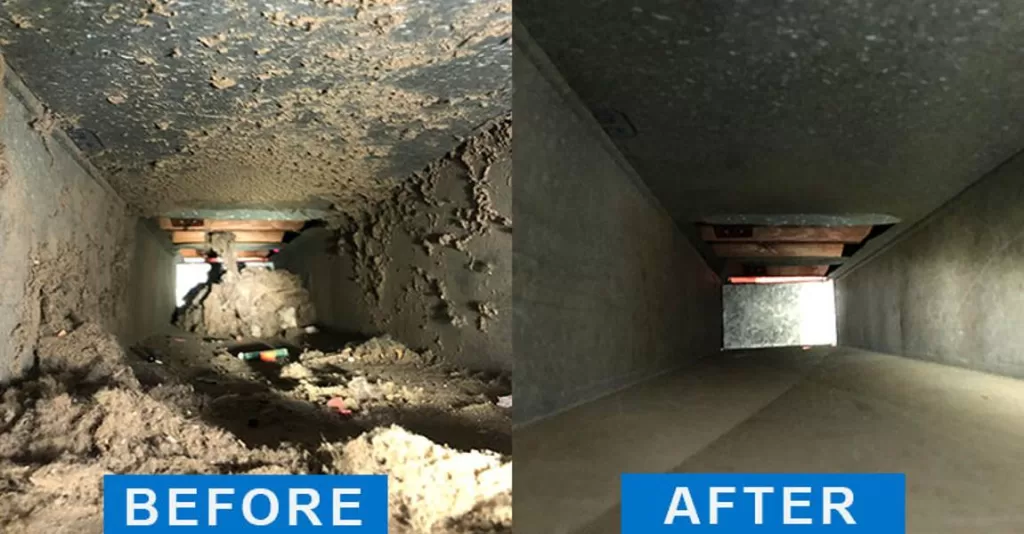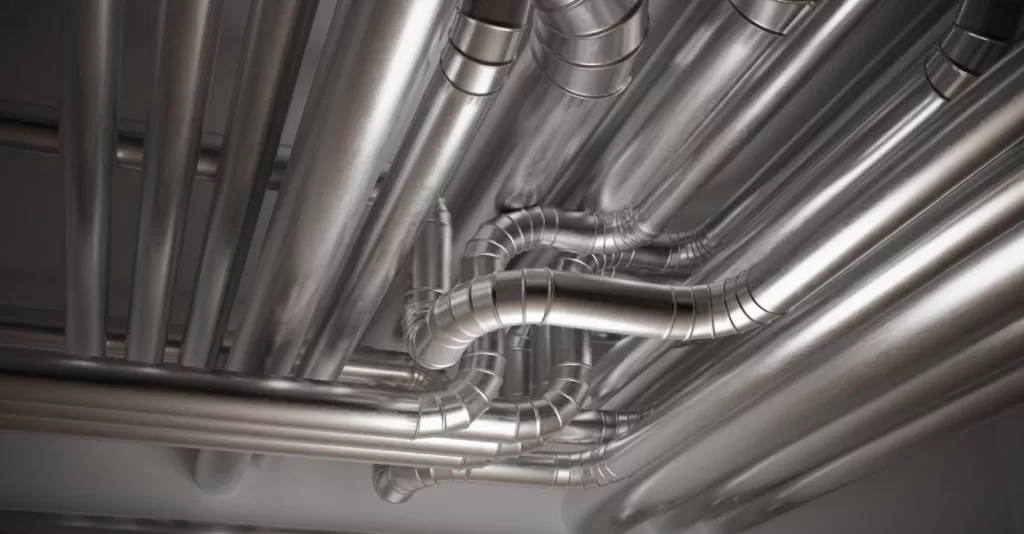Did you know that your air ducts‘ cleanliness can significantly impact your home’s air quality? If you want to breathe clean, fresh air and improve the overall health of your home, then air duct cleaning is a must.
In this complete guide to air duct cleaning, we will cover everything you need to know about its importance, its benefits, and how to get your air ducts cleaned.

Table of Contents
Improving Indoor Air Quality and HVAC Efficiency
Improving indoor air quality and HVAC efficiency involves several key steps. Start by scheduling regular air duct cleaning to remove dust, debris, and allergens that can build up and circulate throughout the indoor air.
- High-quality air filters are essential to capture smaller particles and improve air quality.
- Maintaining a consistent cleaning schedule for filters, vents, and ductwork is crucial for running the system efficiently.
- Sealing and insulating ducts can prevent air leaks and improve overall HVAC performance.
- Scheduling regular HVAC maintenance, including checking for leaks or blockages, can ensure the system runs at its best.
You can significantly improve indoor air quality and HVAC efficiency, creating a healthier and more comfortable indoor environment for everyone.
Air Duct Cleaning Process
Air duct cleaning removes dust, pollen, pet dander, and other allergens, debris, and other contaminants from the air ducts in a building. This is typically done using specialized tools by air duct cleaning professionals.
Over time, dust and other particles can accumulate within the air ducts, which can then be circulated throughout the building or home, potentially leading to poor indoor air quality. Having the ducts clean can help improve the overall air quality and the efficiency of the HVAC system.
Air duct cleaning involves using high-powered vacuums and brushes to dislodge and remove the accumulated dust and debris from the ductwork.
The process also includes cleaning the various components of the heating and cooling system, such as the grilles, registers, and air handlers.
Regular air duct cleaning can also help reduce the risk of mold growth within the ductwork.
Cleaning is an important maintenance task that helps improve indoor air quality and the overall efficiency of the HVAC system.
Hiring a professional air duct cleaner can ensure the job is done thoroughly and effectively, providing a cleaner and healthier environment for building occupants.
How do Air Ducts Get Dirty?
They can become dirty due to a variety of factors.
Household dust, allergens, and debris can accumulate in the ductwork, reducing indoor air quality and decreasing HVAC system efficiency.
The amount of dust and debris that gets trapped in the ducts can depend on factors such as the frequency of cleaning, the presence of pets in the household, and the local environment.
In addition to dust and debris, dirty air ducts can also harbor potential contaminants such as mold, insects, rodents, and animal droppings. These pollutants can pose serious health risks to the occupants of the building, especially those with respiratory conditions or allergies.
It is important to schedule regular cleaning to maintain a healthy and comfortable living environment.
This process helps to remove built-up dust and debris, as well as potential contaminants, improving indoor air quality and ensuring the efficiency of the HVAC system.
By keeping them clean, homeowners can also reduce the risk of encountering unpleasant surprises such as dead rodents or excessive pet hair within the ductwork. Regular cleaning is essential for promoting a safe and healthy indoor environment.
According to the National Air Duct Cleaners Association (NADCA), the average six-room house collects up to 40 pounds of dust, allergens, and other contaminants in its air ducts every year.

Common Signs Your Air Ducts Need Cleaning
Common signs indicating they need cleaning include visible mold growth, a musty odor from the registers, increased dust accumulation, and higher energy bills.
Visible mold growth in your air ducts poses a health risk and hinders your HVAC system’s efficiency. The presence of mold indicates excess moisture in the ducts, which can lead to further damage if left untreated.
A musty odor coming from the registers is often a sign of mold or mildew growth. This indicates poor air quality and can exacerbate respiratory issues.
Increased dust accumulation in your home can result from dirty air ducts. When dust and debris build-up, they are circulated throughout the home, leading to allergies and respiratory problems.
Higher energy bills can result from clogged air ducts, as the HVAC system has to work harder to maintain the desired temperature.
Addressing these issues promptly is crucial for maintaining optimal air quality and preventing further damage to your HVAC system. Regular maintenance can improve air circulation, reduce allergens, and extend the lifespan of your system. It can also help prevent issues such as rodent infestation and air duct repairs.
What are the Different Cleaning Methods?
There are several different methods for cleaning air ducts, including the popular vacuum and brush method. This method involves using a vacuum equipped with a high-powered rotating brush to dislodge and remove dust, debris, and other contaminants from the ductwork. This method is effective because it physically dislodges and removes buildup within the ducts. Its limitation lies in its inability to clean the coils and the use of chemicals to kill bacteria.
Other methods include using compressed air and agitation tools to loosen and remove dirt and debris and utilizing a chemical cleaning solution to sanitize and deodorize the ductwork.
Each method has its strengths and limitations and should be performed regularly to keep air ducts clean and improve indoor air quality.
Hiring professional air duct cleaning technicians is essential to ensure a thorough and effective job and avoid falling victim to air duct cleaning scams.
Regular AC vent cleaning and heating duct cleaning are essential for maintaining a healthy and efficient HVAC system.
What Are the Top Benefits of Air Duct Cleaning?
Air duct cleaning is an essential maintenance task for any home or commercial property. Clean air ducts contribute to better indoor air quality and benefit health, energy efficiency, and overall comfort. We will explore the top benefits of cleaning and why it is a worthwhile investment for property owners.
Indoor Air Quality
To improve indoor air quality in your home, it is important to schedule regular cleanings to remove contaminants that are recirculated by the HVAC system. This can help reduce the buildup of dust, mold, and other pollutants in the air ducts, preventing them from being circulated throughout your home.
Addressing activities like smoking and cooking that generate air pollutants is essential. Consider implementing air purifiers to further improve indoor air quality by removing harmful particles from the air.
Regular maintenance of the HVAC system is also crucial for maintaining clean and fresh air. This includes changing air filters as the manufacturer recommends to prevent the buildup of dust and pollutants in the system.
By taking these steps, you can significantly improve the indoor air quality in your home, creating a healthier and more comfortable living space for you and your family.
To improve indoor air quality, it is important to prioritize cleaning, HVAC system maintenance, and addressing activities that generate air pollutants. Implementing air purifiers can further improve the quality of the air you breathe indoors and healthier living.

Benefits of Air Duct Cleaning for Newborns’ Health
Air duct cleaning is of the utmost importance for newborns’ health. Their delicate respiratory systems are highly susceptible to airborne pollutants and allergens.
By having the air ducts cleaned regularly, parents can ensure that the air their newborn breathes is free from dust, mold, pet dander, pollen, and other contaminants that can negatively impact their health.
Clean air ducts promote better air quality and reduce the risk of respiratory issues, allergies, and asthma attacks in newborns.
Parents can create a safe and healthy environment for their newborns by maintaining clean air ducts. This allows them to grow and develop without unnecessary exposure to harmful airborne particles.
Removing Contaminants
from HVAC systems involves the use of agitation devices and continuous negative pressure. First, agitation devices such as rotary brushes or air whips are used to dislodge and loosen contaminants such as dust, dirt, and debris. This agitation process helps break up the buildup within the HVAC system, making removing it easier.
Continuous negative pressure is then applied to the HVAC system, ensuring that any dislodged contaminants are drawn out and collected in a containment unit, preventing them from being released back into the living space. This method is crucial in preventing the spread of allergens and irritants, particularly for individuals with respiratory problems.
Reducing contaminants in HVAC systems is essential for maintaining indoor air quality and preventing adverse health effects.
Proper cleaning and maintenance of HVAC systems can help reduce the risk of allergic reactions and respiratory issues associated with exposure to contaminants.
Implementing these methods can significantly reduce the risk of health issues related to poor indoor air quality, providing a healthier and more comfortable environment for building occupants.
Statistic: The Environmental Protection Agency (EPA) estimates indoor air can be two to five times more polluted than outdoor air. This is because contaminants such as dust, pollen, and dander can accumulate in air ducts and circulate throughout a home or building.
Dust and Allergen Reduction
Regular residential air duct cleaning is essential for reducing dust and allergens in your home. Over time, air ducts can accumulate pet dander, pollen, mold spores, bacteria, and mildew, all contributing to poor indoor air quality. When the air conditioning system is in use, these substances are circulated throughout the home, leading to potential health issues for individuals with allergies or respiratory problems.
Addressing these airborne pollutants is crucial to promoting healthier living for you and your family. Scheduling air conditioning duct cleaning regularly is crucial.
Using high-efficiency particulate air (HEPA) filters in your air conditioner can help trap excessive amounts of dust and allergens.
Regular vacuuming and dusting are also important for preventing the build-up of these substances in the home.
Reducing dust and allergens in your home through regular duct cleaning is a key step in promoting healthier living and improving indoor air quality. Addressing these airborne pollutants can create a cleaner and safer environment for you and your family.
HVAC System Performance
The performance of an HVAC system is crucial to maintaining a comfortable indoor environment. A well-performing HVAC system ensures a healthy and comfortable living or working space, from efficient heating and cooling to proper ventilation.
Monitoring and maintaining the performance of an HVAC system is essential to both energy efficiency and indoor air quality.
Whether you’re a homeowner or a facilities manager, understanding HVAC system performance is essential for creating a comfortable and healthy indoor environment while promoting energy savings and sustainability.

HVAC system efficiency and airflow
Key factors that impact HVAC system efficiency and airflow include regular duct cleaning, proper maintenance, air filter replacement, and the use of energy-efficient equipment.
Regular duct cleaning ensures that the airflow is not obstructed by debris, dust, or other pollutants. Proper maintenance of the HVAC system, including lubricating moving parts, checking electrical connections, and inspecting the condensate drain, can prevent system breakdowns and maintain optimal airflow. Replacing air filters regularly ensures that the air flowing through the system is clean and unobstructed, promoting better airflow. Using energy-efficient equipment can also improve airflow and reduce energy consumption.
These factors contribute to the overall performance of the HVAC system by ensuring that air can flow freely through the ducts and into the living or working space. This helps maintain a comfortable environment and prevent strain on the system, leading to a longer lifespan of HVAC systems.
Maintaining clean return registers is important for optimal airflow, as they are responsible for returning air to the HVAC system for heating or cooling. By prioritizing these factors, individuals can ensure that their HVAC system operates efficiently and provides consistent airflow throughout the home or building.
Air Duct Cleaning Services Cost
The cost of air duct cleaning services can vary depending on the property size, the extent of the cleaning required, and the company providing the service.
On average, the cost can range from $300 to $1000. The cost may be on the lower end of the scale for a smaller home with a straightforward duct system. For larger homes with more complex ductwork, the cost may be higher.
Factors that can impact the cost of air duct cleaning include the number of vents, the presence of mold or other contaminants, and the accessibility of the ductwork. Some companies may also offer additional services, such as sanitizing the ducts or installing UV lights to prevent microbial growth, which can also impact the overall cost.
It’s important to do your research and obtain quotes from several reputable companies before deciding. Be wary of companies offering very low prices, as they may be cutting corners or using substandard equipment.
Investing in professional air duct cleaning can improve indoor air quality and create a more efficient HVAC system, which can have long-term benefits for your health and home.
DIY Duct Cleaning
DIY duct cleaning can save money, but it comes with challenges and limitations compared to professional cleaning. One challenge is reaching all areas of the ductwork, especially in large or complicated systems.
DIY cleaning may also need more professional equipment to thoroughly clean and sanitize ducts.
Common DIY cleaning techniques include using a vacuum with a long hose attachment to remove debris, using a brush to scrub the walls of the ducts, and applying a disinfectant spray to kill mold and bacteria.
Professional cleaning at eliminating stubborn contaminants may be more effective than these methods.
To effectively clean, inspect, and seal any leaks, changing the air filter regularly and ensuring that vents are free from obstruction is important. It’s also vital to use the right tools and techniques to reach all areas of the ductwork, such as a high-powered vacuum and stiff-bristled brushes.
While DIY cleaning can be cost-effective, it may provide a different level of thoroughness and effectiveness than professional cleaning. Before deciding on DIY methods, it is essential to weigh the challenges and limitations.

Frequently Asked Questions (FAQs)
Can air duct cleaning improve my HVAC system’s energy efficiency?
Yes, air duct cleaning can improve your HVAC system’s energy efficiency. Over time, dust, dirt, and other debris can accumulate in the air ducts, obstructing airflow and causing the system to work harder to maintain the desired temperature. By cleaning the air ducts, you can remove these obstructions and allow air to flow freely, reducing the strain on your HVAC system and improving its energy efficiency.
How often should I have my air ducts cleaned?
It is recommended to have your air ducts cleaned every 3-5 years.
Can I clean my air ducts myself, or should I hire professionals?
It is generally recommended that you hire professionals to clean your air ducts. While cleaning your air ducts yourself is possible, it can be challenging and time-consuming.
Professionals have the necessary equipment and expertise to effectively clean the air ducts, ensuring that all contaminants and buildup are properly removed. They can also identify and address any potential issues or damage during cleaning. Hiring professionals ensures a thorough and efficient cleaning, promoting better indoor air quality and maximizing the performance of your HVAC system.
Is air duct cleaning necessary if I regularly change my air filter?
Even if you regularly change your air filter, air duct cleaning is still necessary. While changing the air filter is important for maintaining indoor air quality, it only filters out particles that have already entered the system. Regular air duct cleaning can help remove accumulated pollutants, improving indoor air quality and preventing potential issues such as reduced airflow and increased energy consumption.
What are the potential risks associated with air duct cleaning?
There are potential risks associated with air duct cleaning. These risks include damage to the ductwork, introducing harmful contaminants into the air, and inadequate cleaning that can leave behind debris or mold. Hiring a reputable and experienced professional to minimize these risks and ensure proper cleaning and maintenance of air ducts is important.
A study published in the Environmental Science & Technology journal found that regular air duct cleaning can significantly reduce indoor airborne allergens and improve indoor air quality. The study showed that cleaning air ducts reduced the concentration of airborne allergens by an average of 85%.
Conclusion
In conclusion, the Complete Guide to Air Duct Cleaning provides a comprehensive overview of everything you need to know about this important maintenance task.
It covers the benefits of cleaning, the signs that indicate it is necessary, and the process and equipment involved. The guide also addresses common misconceptions and offers tips for finding a professional air duct cleaning service. This guide is a valuable resource for anyone looking to understand the importance of air duct cleaning and how to ensure the air quality in their home or business.
It is recommended that you schedule a professional check-up for your HVAC system to ensure optimal performance and avoid costly repairs in the future. Don’t hesitate to contact our HVAC experts to schedule your appointment and maintain a comfortable, energy-efficient home.


